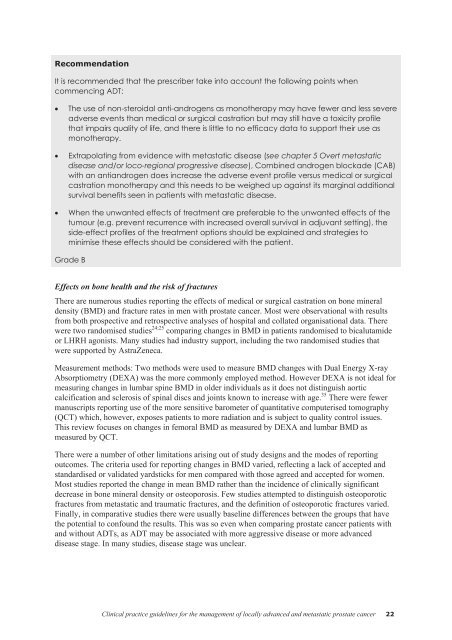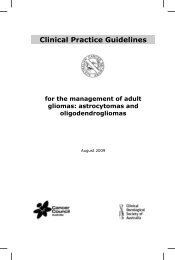Clinical Practice Guidelines for the management of locally advanced ...
Clinical Practice Guidelines for the management of locally advanced ...
Clinical Practice Guidelines for the management of locally advanced ...
You also want an ePaper? Increase the reach of your titles
YUMPU automatically turns print PDFs into web optimized ePapers that Google loves.
Recommendation<br />
It is recommended that <strong>the</strong> prescriber take into account <strong>the</strong> following points when<br />
commencing ADT:<br />
The use <strong>of</strong> non-steroidal anti-androgens as mono<strong>the</strong>rapy may have fewer and less severe<br />
adverse events than medical or surgical castration but may still have a toxicity pr<strong>of</strong>ile<br />
that impairs quality <strong>of</strong> life, and <strong>the</strong>re is little to no efficacy data to support <strong>the</strong>ir use as<br />
mono<strong>the</strong>rapy.<br />
Extrapolating from evidence with metastatic disease (see chapter 5 Overt metastatic<br />
disease and/or loco-regional progressive disease), Combined androgen blockade (CAB)<br />
with an antiandrogen does increase <strong>the</strong> adverse event pr<strong>of</strong>ile versus medical or surgical<br />
castration mono<strong>the</strong>rapy and this needs to be weighed up against its marginal additional<br />
survival benefits seen in patients with metastatic disease.<br />
When <strong>the</strong> unwanted effects <strong>of</strong> treatment are preferable to <strong>the</strong> unwanted effects <strong>of</strong> <strong>the</strong><br />
tumour (e.g. prevent recurrence with increased overall survival in adjuvant setting), <strong>the</strong><br />
side-effect pr<strong>of</strong>iles <strong>of</strong> <strong>the</strong> treatment options should be explained and strategies to<br />
minimise <strong>the</strong>se effects should be considered with <strong>the</strong> patient.<br />
Grade B<br />
Effects on bone health and <strong>the</strong> risk <strong>of</strong> fractures<br />
There are numerous studies reporting <strong>the</strong> effects <strong>of</strong> medical or surgical castration on bone mineral<br />
density (BMD) and fracture rates in men with prostate cancer. Most were observational with results<br />
from both prospective and retrospective analyses <strong>of</strong> hospital and collated organisational data. There<br />
were two randomised studies 24;25 comparing changes in BMD in patients randomised to bicalutamide<br />
or LHRH agonists. Many studies had industry support, including <strong>the</strong> two randomised studies that<br />
were supported by AstraZeneca.<br />
Measurement methods: Two methods were used to measure BMD changes with Dual Energy X-ray<br />
Absorptiometry (DEXA) was <strong>the</strong> more commonly employed method. However DEXA is not ideal <strong>for</strong><br />
measuring changes in lumbar spine BMD in older individuals as it does not distinguish aortic<br />
calcification and sclerosis <strong>of</strong> spinal discs and joints known to increase with age. 35 There were fewer<br />
manuscripts reporting use <strong>of</strong> <strong>the</strong> more sensitive barometer <strong>of</strong> quantitative computerised tomography<br />
(QCT) which, however, exposes patients to more radiation and is subject to quality control issues.<br />
This review focuses on changes in femoral BMD as measured by DEXA and lumbar BMD as<br />
measured by QCT.<br />
There were a number <strong>of</strong> o<strong>the</strong>r limitations arising out <strong>of</strong> study designs and <strong>the</strong> modes <strong>of</strong> reporting<br />
outcomes. The criteria used <strong>for</strong> reporting changes in BMD varied, reflecting a lack <strong>of</strong> accepted and<br />
standardised or validated yardsticks <strong>for</strong> men compared with those agreed and accepted <strong>for</strong> women.<br />
Most studies reported <strong>the</strong> change in mean BMD ra<strong>the</strong>r than <strong>the</strong> incidence <strong>of</strong> clinically significant<br />
decrease in bone mineral density or osteoporosis. Few studies attempted to distinguish osteoporotic<br />
fractures from metastatic and traumatic fractures, and <strong>the</strong> definition <strong>of</strong> osteoporotic fractures varied.<br />
Finally, in comparative studies <strong>the</strong>re were usually baseline differences between <strong>the</strong> groups that have<br />
<strong>the</strong> potential to confound <strong>the</strong> results. This was so even when comparing prostate cancer patients with<br />
and without ADTs, as ADT may be associated with more aggressive disease or more <strong>advanced</strong><br />
disease stage. In many studies, disease stage was unclear.<br />
<strong>Clinical</strong> practice guidelines <strong>for</strong> <strong>the</strong> <strong>management</strong> <strong>of</strong> <strong>locally</strong> <strong>advanced</strong> and metastatic prostate cancer<br />
22



